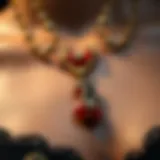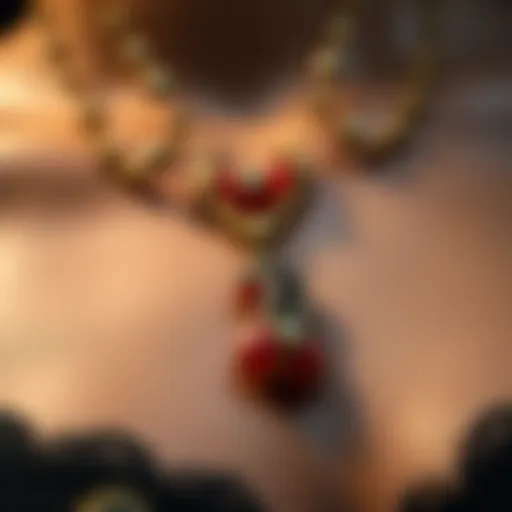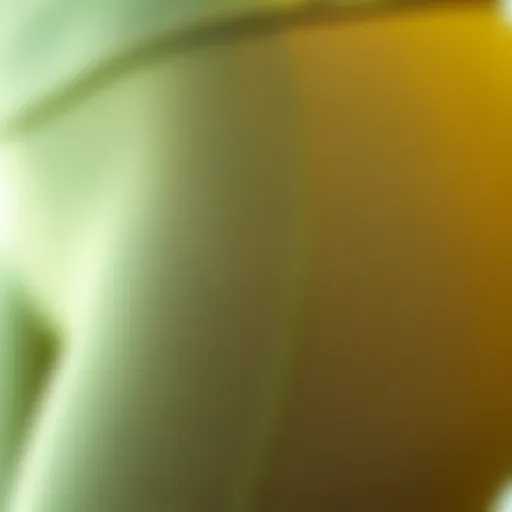Corset Cinches: A Stylish Exploration of History


Intro
Corset cinches have made a remarkable return to the fashion scene, drawing in enthusiasts and novices alike. This fascinating garment is not merely an accessory; it's a symbol woven deeply into the fabric of fashion history. These elements of clothing have consistently evolved, adapting to the whims of society, technology, and personal expression. Garments once restricted by modern standards are now celebrated for their role in enhancing personal style, and their craft is appreciated more than ever.
Understanding corset cinches goes beyond mere aesthetics. It opens a portal to historical contexts, revealing how these garments shaped the views on body image and femininity over the centuries. With that in mind, let’s step into the world of fashionable corsets, exploring their trends, materials, and their interplay with modern fashion.
Prolusion to Corset Cinches
Corset cinches play a pivotal role in the broader dialogue about fashion and body image. Rooted in history yet flourishing in contemporary culture, they represent a bridge between the past and present. Understanding corset cinches begins not just with the garment itself, but also with the cultural currents that shaped its evolution. The importance of this topic lies in its multifaceted nature—the exploration of style, structure, and the intricate layers of meaning that corsetry encapsulates.
As we journey through this complex subject, we sift through historical precedents, the emergence of modern traditions, and the impact of craftsmanship on personal expression. Corset cinches are more than just pieces of attire; they are laden with symbolic significance that speaks volumes about societal standards of beauty and the choices we make in terms of self-presentation.
A well-rounded understanding of corset cinches can illuminate various aspects of fashion today. It not only encourages awareness of construction techniques but also allows insights into how one can style these garments to enhance their wardrobe. Corset cinches insists on a consideration of ethical production practices in the fashion industry, emphasizing sustainability as an essential element in design.
This connection between corset cinches and the ongoing fashion narrative offers benefits that reach beyond mere aesthetics. Ultimately, knowledge about these garments helps fashion enthusiasts and boutique owners to make informed decisions in both style and sourcing. In the subsequent sections, we will delve deeper into the historic significance of corsets, unraveling the complex threads that compose their narrative and highlighting how these garments have impacted our perceptions of beauty and identity.
Historical Importance of Corsets
Corsets have long been a source of fascination and controversy, tracing their roots back to various historical periods. Initially, they were utilitarian garments—protective, supportive, and even essential for certain tasks. As society evolved, so did the corset's role in defining the silhouette of the time.
The narrative of the corset is rich with cultural importance, intertwined with shifts in gender perceptions and roles. It serves as a reflection of societal norms, where the body’s shape often dictated one's place in the world. Corsets navigated through the rigid constructs of various centuries, notably the Victorian era, where they became synonymous with femininity.
"Corsetry didn’t just shape the body; it shaped the very essence of how women were seen and saw themselves in society."
This interplay of form and function underscores the broader implications of wearing a corset. The hysteria surrounding them often stemmed from their tight confines, resulting in a dichotomy where beauty was both revered and critiqued.
Definition and Function of Corset Cinches
At their core, corset cinches are designed to sculpt and enhance the body's shape. Unlike traditional corsets, which are typically constructed with a defined structure, cinches focus more on accentuating the waistline, providing a flattering silhouette without the full-body encasement.
Understanding the functionality of corset cinches requires a glance at their main components:
- Fit: Corset cinches are generally more adjustable than historical corsets, offering versatility in size and compression.
- Support: Depending on the design, they provide varying degrees of support, from slight waist contouring to more defined definitions of curves.
- Style: Cinches can be worn over or under clothing, making them adaptable for both casual and formal attire.
In today's fashion milieu, corset cinches serve as an essential accessory, not just a garment but a tool for self-styling. They can elevate a simple outfit, making the wearer feel empowered and fashionable. Through thoughtful integration into modern wardrobes, these cinches reflect an ongoing dialogue about body representation and personal choice.
The Evolution of Corsetry
The journey of corsetry is like a thread weaving through the tapestry of fashion history. Understanding this evolution provides insight not just into garments, but into societal norms, cultural shifts, and personal expressions of femininity and strength. Corsets have undergone significant transformations from their functional origins to their role as fashion statements today. This section elaborates on those changes and emphasizes how corsetry echoes the human experience in relation to body image, societal expectations, and the shifting notions of beauty.
From Victorian Times to Modern Fashion
In the Victorian era, corsets were synonymous with femininity. Women wore them for support and shape, often tightly laced to create an exaggerated hourglass figure. The Victorian fashion police monitored their use closely, with rules dictating the ideal waist size. Corsets weren't merely garments; they were symbols of social status and moral integrity. A well-fitted corset indicated proper upbringing and adherence to societal norms.
However, as the 20th century crept in, attitudes toward corsets began to shift. The rise of suffragism and women’s liberation movements brought about a more pragmatic approach to women's attire. Corsets lost their popularity amid the advent of more comfortable and liberating styles such as the flapper dress.
Fast-forward to contemporary fashion, where corsets have seen a surprising revival. Designers reintegrated corsetry into modern silhouettes, transforming what was once viewed solely as restrictive into pieces of art and self-expression. Unlike before, today's corsets are embraced for their ability to empower wearers, challenge conventional beauty standards, and make bold statements. Influential names in fashion, such as Jean Paul Gaultier and Alexander McQueen, have notably pushed the boundaries of corsetry, illustrating its adaptability and ongoing relevance.
Significant Changes in Design and Fabric
Throughout history, the design and materials of corsets have evolved significantly, reflecting the advancements in textile manufacturing and shifts in aesthetic preferences.
- Traditional Materials: The classic corset was typically constructed from materials including whalebone and steel. Whalebone, derived from the baleen of whales, provided flexibility and structure but also came with ethical concerns that echoes through today’s discourse surrounding sustainable fashion. Steel corsets offered more durability and support but could sometimes feel cold and daunting against the skin.
- Modern Alternatives: Today, designers often favor materials like high-quality cotton, jacquard, and various synthetic fabrics that prioritize comfort without sacrificing style. The modern corset utilizes elements like stretch panels and breathable fabrics, which allow for better ease of movement, making them suitable for everyday wear.
- Craftsmanship and Innovation: Alongside materials, the craftsmanship behind corsets has dramatically improved. Techniques that once relied heavily on hand-sewing have evolved into precision manufacturing processes. Advanced design software now helps in customizing fit, and the inclusion of 3D printing technology brings about new possibilities in corset design.
"Embracing the evolution of corsetry means recognizing the interplay between fashion and the times, reflecting changes in norms, beliefs, and personal identity."
Materials and Construction Techniques
When it comes to corset cinches, the choice of materials and the techniques used in their construction play a pivotal role in determining both their aesthetic appeal and functional performance. The intricate craftsmanship involved not only shapes the corset’s silhouette but also influences its comfort and durability. Understanding these elements helps enthusiasts appreciate the artistry behind these garments and the ongoing evolution within corsetry.
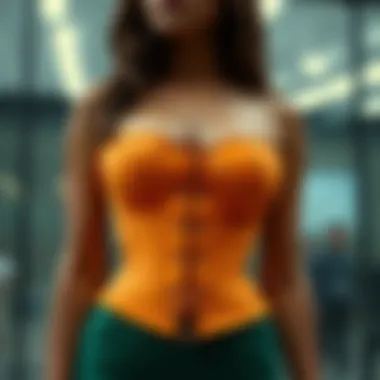

Traditional Materials: Steel and Whalebone
Historically, corsets were constructed using materials like steel and whalebone—also known as baleen. Steel provided the necessary rigidity, allowing corsets to maintain their shape and effectively create the desired curvaceous figure. The advent of steel boning in the mid-19th century revolutionized lingerie, offering wearers greater support and a more defined silhouette compared to previous methods utilizing less sturdy materials.
"The combination of steel and whalebone was not merely practical; it defined a period of fashion where the ideal body shape was strictly governed by the limitations of the corset itself."
On the other hand, whalebone, being lightweight and flexible, allowed for movement while still providing some structure. Many vintage corsets showcase a masterful blend of these materials, emphasizing both artistry and functionality. However, the use of whalebone has fallen out of favor, primarily due to ethical concerns surrounding whaling. As the world changes, many fashion designers seek alternatives that respect animal rights while still paying homage to traditional craftsmanship.
Modern Alternatives: Cotton and Synthetic Fabrics
In today’s fashion landscape, cotton and synthetic fabrics have emerged as popular alternatives for corsetry. Cotton is favored for its breathability and comfort, making it suitable for everyday wear. It tends to be softer against the skin compared to its traditional counterparts, appealing to a modern audience that prioritizes comfort along with style. This shift marks a significant change in consumer attitudes, emphasizing the importance of wearability.
Synthetic fabrics, such as spandex and polyester blends, offer unique advantages too. These materials often provide more stretch and flexibility, enhancing comfort and ease of movement. Additionally, they can be engineered for specific purposes, such as moisture-wicking or support. When paired with traditional corsetry techniques, they create a fusion of old and new, allowing modern corset wearers to explore styles with a contemporary twist.
Craftsmanship in Corset Making
Craftsmanship is the heartbeat of corset construction. Modern corset makers blend historical methods with innovative techniques, ensuring each piece is not just functional but also a work of art. This fusion involves meticulous attention to detail, from pattern drafting to the final fitting. Many artisanal corset designers take a bespoke approach, tailoring each garment to the individual body, which means no two corsets are alike.
While mass-produced options exist, bespoke corsets offer a level of personalization that mass-market items cannot replicate. This craftsmanship often reflects the designer's personal aesthetic and can range from intricate embroidery to the choice of color and fabric. Even the sewing techniques—such as French seams or bias binding—reveal the maker's dedication to quality.
In sum, the materials and construction techniques used in corset cinches not only shape the garment’s integrity and usability but also highlight the rich history and artistry that continue to influence modern fashion. As corsetry evolves, the ongoing interplay of traditional and contemporary elements creates a dynamic landscape for both designers and enthusiasts alike.
Cultural Significance of Corsets
The cultural significance of corsets extends beyond mere fashion statements; they are a canvas showcasing societal norms, body standards, and even gender roles through the ages. Corsets have played a pivotal role across various civilizations, serving not only as garments but also as symbols of status and ideals of femininity. This article section aims to unpack how corsets interact with different cultures and how they've shaped, and been shaped by, the evolving perception of beauty.
Corsets in Different Cultures
Corsets are found in myriad forms around the world, each with its unique context and significance. In Western cultures, like the intricate designs of the Victorian era, corsets were not just clothing but rather a statement of social class and virtue. Women laced into these corsets epitomized refinement and ladylike behavior, while also adhering to the constraints of a patriarchal society.
Many cultures have their variations of body shaping garments that echo the philosophy behind corsets. In parts of Africa, for instance, women wear ebuma, a type of tight-fitting bodice that serves a similar purpose to corsets in terms of body shaping and societal expectations. To some extent, these garments celebrate curvaceous figures, contrasting with the Western ideal that often prizes a thinner silhouette.
- Traditional Chinese qipao emphasizes a defined waist without the restrictive properties of a corset, yet it still suggests a silhouette that fits the cultural notion of femininity.
- The ancient Japanese obi, while not a corset, illustrates how waist cinching creates shape and formality in attire, illustrating cultural values surrounding modesty and elegance.
While the structural role of corsets has waned in some societies, many cultures maintain their legacy in a modern context, crafting fashion that pays homage to historical significance while redefining beauty standards.
Perceptions of Beauty and Body Image
The corset's layered history intertwines with perceptions of beauty, which have shifted dramatically through centuries. Once viewed as the epitome of grace and allure, the tightly laced corset has been both revered and reviled. In an era where ‘thin’ was idealized, corsets offered a means to achieve that look, binding women into shapes that fit the dominant aesthetic of the time.
"The corset can be seen as a powerful talisman, shaping not only the body but also how women perceived themselves within the confines of societal expectations."
Yet as discussions around body image evolve, the symbolism of corsets has also transformed. The current body positivity movement often scrutinizes the corset’s role, suggesting it perpetuates unattainable beauty ideals. Many individuals and groups now advocate for a more inclusive understanding of beauty, using corsets as a point of reflection rather than an aspirational benchmark.
The resurgence of corsets in contemporary fashion highlights this complex relationship. They are celebrated in fashion weeks around the world and feature in modern wardrobes, but often embraced in a way that encourages self-expression rather than oppression. They are reimagined as part of the empowerment narrative, allowing wearers to reclaim autonomy over their bodies and how they choose to adorn them.
Culturally, corsets continue to challenge and punctuate discussions on body image. As fashion enthusiasts and curators, the implications of how corsets fit into personal narratives around body shape, beauty, and identity remain relevant and rich grounds for exploration.
Corset Cinches in Contemporary Fashion
Corset cinches have surged in relevance within today's fashion landscape, transforming from a historical garment into a modern staple for style and self-expression. This resurgence is not merely a revival of old trends, but rather a thoughtful reintegration of corsets into various aspects of contemporary fashion. As fashion enthusiasts explore their unique identities, corset cinches offer tools not only for shaping garments but also for crafting narratives about body image and empowerment.
Resurgence in Popular Culture
In the past few years, the influence of corsets has made a noticeable comeback in popular culture. Celebrities and influencers frequently embrace this trend, rocking corsets in various interpretations that blend vintage aesthetics with contemporary flair. From red carpet events to everyday street style, corsets have become synonymous with individuality. Designers and fashion houses are capitalizing on this excitement, often incorporating corset elements in their collections, appealing to a wide demographic. This fabrics of modern influence are seen in brands such as Dior and Alexander McQueen, where corsetry is strategically woven into their designs.
A notable example includes the high-fashion looks seen in music videos or editorial shoots. Iconic figures like Billie Eilish and Rihanna have made corsets a powerful statement piece, celebrating the garment's ability to enhance their personal aesthetics. Besides, social media platforms are awash with tutorials and style guides illustrating how to wear corsets in a chic, everyday manner.
"Corsets have transitioned beyond mere garments; they are now a canvas for self-expression."
Styling Corsets for Everyday Wear


The versatility of corset cinches allows for an array of styling options, making them suitable for various occasions. Here are some ideas on how to seamlessly integrate them into your wardrobe:
- Layering with Tops: Wear a corset over a simple white tee or a fitted turtleneck. This unexpected contrast elevates the simplicity of everyday wear.
- Dresses with Flair: Pair a corset with a flowy dress. This creates a striking silhouette, cinching the waist while allowing for the dress's fabric to drape elegantly.
- Jeans and Corsets Combo: For a casual yet stylish look, combine high-waisted jeans with a corset. This pairing not only offers comfort but also brings attention to the waist without sacrificing style.
- Accessorizing: Don't forget to consider accessories! A corset can be beautifully complemented with statement necklaces or dangling earrings, enhancing its visual appeal.
For those venturing into this realm for the first time, it's ideal to start with softer fabrics, allowing for comfort without losing the unique aesthetic. As confidence grows, more structured options can be explored. The adaptability of corset cinches speaks volumes in fostering a modern understanding of body positivity and stylistic expression. By considering these options, wearers can cultivate an ensemble that reflects who they are while embracing the historical significance of corsetry.
The Role of Corsetry in Fashion Design
Corsetry has a noteworthy position in the world of fashion design, serving as more than just a functional garment. It's a bridge between the historical and the contemporary, offering designers a canvas to explore creativity while adhering to the dictates of body shaping and aesthetic appeal. The marriage of form and function in corsets makes them an enduring feature on the runway and within high-fashion collections.
One of the primary benefits of integrating corsets into fashion design is their unique ability to transform silhouettes. A well-constructed corset can cinch the waist, enhance the bust, and create an hourglass figure that has been long celebrated in fashionable eras. This transformative quality is what allows designers to manipulate figures to their desired vision, creating striking, memorable looks. Moreover, corsets are not confined to traditional purposes. In the hands of innovative designers, they can evolve into experimental forms that challenge contemporary notions of beauty and body image.
Influence on Fashion Designers
Fashion designers throughout the ages have drawn inspiration from the corset. Icons like Vivienne Westwood and Alexander McQueen have utilized the structure of the corset in avant-garde collections, taking its traditional use and flipping it on its head. The corset becomes a symbol of rebellion against rigid beauty standards, often highlighted in collections that celebrate individualism and empowerment.
Famous designers recognize how corsets transcend mere fabric and stitching; they are statements that evoke history and artistry. With a nod to the past while tipping the hat to the future, they craft narratives through corsetry. Consider a collection where corsets are paired with casual streetwear—a juxtaposition that sparks conversation on gender norms and body image.
Corsets on the Runway
The runway is where the allure of corsets is often showcased in full vibrance. From Paris to Milan, designers unveil collections that redefine how corsets are positioned in the context of modern wear. Take, for instance, the striking use of corsets in the Dolce & Gabbana Spring 2020 collection, where traditional motifs were given a fresh twist through contemporary styling and layering.
During fashion weeks, you can observe how corsets are styled in ways that purposefully clash with other garments. Layering over oversized shirts or under flowing dresses, they push the boundaries of conventional dress codes. This boldness not only redefines femininity but also allows for personal expression that resonates with diverse audiences.
"Corsets have moved beyond the confinements of undergarments; they can now be intriguing statements of identity and creativity."
As trends continue to shift, the role of corsets in fashion design remains pivotal. They offer a means of artistic expression vital for both designers and wearers. Elements like color, fabric choice, and embellishments further enhance the conversation surrounding this intricate garment, making corsetry a rich field within fashion that will continue to spark both admiration and debate.
Sustainable Practices in Corset Production
Sustainable practices in corset production have become a noteworthy topic in the ever-evolving fashion landscape. With the fashion industry frequently critiquing traditional approaches for their environmental impact, there is a growing focus on methods that promote sustainability while maintaining quality. As we break down this subject, we'll look into ethical fabric choices and waste reduction strategies that make a significant difference in reducing the industry's carbon footprint.
Ethical Fabric Choices
When it comes to ethical fabric choices, the selection is vast. More and more designers are looking towards organic and sustainable materials that do not compromise on comfort or style. Cotton that is grown without synthetic pesticides and fertilizers not only feels great but also supports healthier ecosystems. Additionally, hemp and bamboo are gaining traction due to their rapid growth cycles and minimal water usage.
Furthermore, the use of recycled fabrics cannot be overlooked. Brands are experimenting with materials sourced from post-consumer waste, including plastic bottles and discarded textiles, breathing new life into products that would otherwise contribute to landfill waste. This shift towards recycling not only reduces dependency on raw materials but also curtails production pollution. A step toward sustainability is also about fostering transparency in sourcing; consumers are becoming increasingly aware of where their clothing comes from and how it impacts the planet.
"The choice of fabric is pivotal. A mindful selection not only paves the way for better products but also sets a precedent for responsible fashion practices."
Reducing Waste in Corset Production
On the matter of waste reduction, several strategies come into play. One notable approach is optimizing patterns to maximize fabric usage. This involves intricate planning to ensure that every inch of material is utilized - less waste fragments means less environmental strain.
Moreover, embracing small-batch production instead of mass manufacturing can lead to significant reductions in overproduction, which is a major contributor to waste. When items are produced in smaller quantities, they often exhibit better craftsmanship, ensuring that quality is not sacrificed for quantity.
Other manufacturers delve into upcycling, where leftover fabric scraps are transformed into additional corset styles or accessories. This creative reuse minimizes waste while presenting unique designs that stand apart from conventional pieces. Implementing better inventory management practices also helps in anticipating trends and reducing surplus stock.
Accessorizing with Corset Cinches
Accessorizing with corset cinches not only enhances an outfit, but it also illustrates personal style and interpretation of fashion. By incorporating these garments creatively into one’s wardrobe, individuals can add elegance and even an edge to what might otherwise be simple ensembles. This section delves into how corset cinches can blend harmoniously with different clothing styles and accessories, thus broadening their appeal and usage.
Complementary Clothing Styles
When considering what to pair with corset cinches, one has a wealth of choices. Think versatile pieces that can either elevate or tone down the intensity of a cinch.
- Dresses: Corset cinches can be worn over or under dresses to create a unique silhouette. For example, placing a cinch over a flowing maxi dress can give a flattering waistline while maintaining the dress's romantic vibe.
- Tops: A simple fitted top under a corset cinch can transform a casual outfit into something chic. Additionally, wearing a cinch with peplum blouses can accentuate curves beautifully, defining the waist.
- Outerwear: Layering a corset over a tailored jacket can turn an ordinary look into a statement piece. Consider a fitted blazer adorned with a cinch over it for a bold, modern appearance.
- Skirts and Pants: High-waisted skirts and trousers naturally complement corset cinches. They can create length while harmonizing with the waistline enhancement that the cinch provides.
Pairing these styles ensures that the corset cinch is used not merely as an undergarment, but rather as a pivotal component of the outfit itself.
Footwear and Accessories to Pair
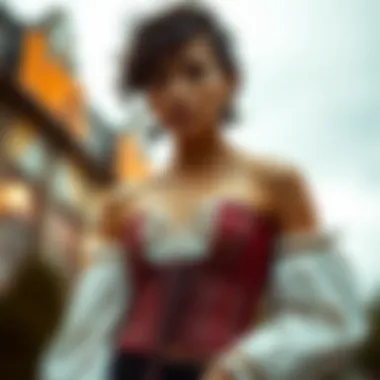

Footwear and accessories play critical roles in completing a look that features corset cinches. The right pair can support the theme you wish to express.
- Boots: Ankle or thigh-high boots work beautifully with corsets, especially in edgy styles. They can add a touch of drama while allowing the cinch to be the focus of attention.
- Heels: Stilettos or block heels can lend an air of sophistication. Delicate styles would work nicely with feminine outfits, while chunkier heels could balance out the structure of a corset cinch.
- Accessories: When it comes to jewelry, opting for statement pieces can highlight the look without overwhelming it. Think bold earrings or layered necklaces that draw eyes upward, inviting admiration of the overall ensemble.
- Bags: Choose bags that either contrast or coordinate with the color and fabric of the corset. A structured handbag can echo the formality of the corset cinch, while a slouchy bag can soften the look.
Ultimately, incorporating various clothing styles and accessories allows for both flexibility and creativity when styling corset cinches. Every choice you make can reflect not just personal taste, but also celebrate the art and history surrounding this iconic fashion element.
Challenges and Controversies Surrounding Corsets
The subject of corsets frequently garners attention, provoking varied opinions. In the world of fashion, where expression and comfort meet, discussing the challenges and controversies surrounding corsets is essential. While many view corsets as a nostalgic piece, others raise valid concerns, especially relating to health and the philosophies of body image. Understanding these elements can help fashion enthusiasts, boutique owners, and everyday wearers navigate the complex environment surrounding these garments.
Health Implications
Health implications linked to corset wear have long been debated. Historically, tighter corseting has led to myriad physical concerns. These include digestive issues, respiratory challenges, and spinal deformities. Some wearers, in pursuit of that hourglass silhouette, might choose a size that could compromise their health. However, it’s worth noting that modern corseting practices have evolved, focusing more on comfort and body positivity.
Corset manufacturers today, like Journelle and Hopeless Lingerie, prioritize the wearer's safety without sacrificing style. They utilize materials that help in providing support while being more forgiving on the body. Here are some points worth considering:
- Breathability: Newer fabrics enhance airflow, helping the wearer stay comfortable.
- Structure vs. Restriction: A well-constructed corset offers support without excessive tightness, which helps mitigate health risks.
- Education: Today's wearers can obtain valuable resources on how to wear corsets safely, adjusting sizes and styles to avoid discomfort.
Health should always come first. Corsets should enhance your figure, not hinder your well-being.
Debates on Body Positivity
The corset has a unique position at the intersection of beauty standards and body positivity. On one hand, some argue that corsets perpetuate outdated ideals about body shapes and can pressure individuals to conform to unrealistic standards. On the other hand, many assert that corsets can empower self-expression and allow for diverse interpretations of beauty.
As conversations around body image evolve, debates surrounding the use of corsets continue. Here are some facets of the body positivity discourse:
- Empowerment vs. Conformity: For some, wearing a corset is a statement of empowerment, celebrating curves and sexuality. Others see it as shackling one's natural form, reflecting societal pressures.
- Cultural Context: Corsets have been embraced differently across cultures. While some women view them as an art form, others might see them as a relic of oppressive practices.
- Diverse Body Types: The contemporary corset scene is embracing broader body types, showcasing models in varied shapes and sizes. This representation is critical in countering misconceptions.
Future of Corset Cinches in Fashion
As fashion continues to evolve, the place of corset cinches is becoming increasingly significant. Their ability to combine historical elegance with modern innovation means they're not just a passing trend but a vital part of the contemporary style narrative. Delving into this intricacy reveals why corset cinches are poised to hold sway in both high fashion circles and everyday wear.
Innovations in Design and Function
Today's designers are thinking outside the box, merging original corset structures with cutting-edge materials and techniques. This intersection of art and science opens a door to numerous possibilities:
- Smart Fabrics: Designers are experimenting with fabrics that adapt to body temperature and movement. This adaptability provides comfort without sacrificing style—a crucial factor for today’s fashion-savvy consumers.
- Modular Elements: Some brands are exploring modular designs, allowing wearers to adjust the fit or style according to their preferences or occasions. These innovations foster a more personalized, intimate dressing experience.
- Sustainability: With increasing awareness regarding climate change, sustainable methods in corset production are gaining ground. Among these, cruelty-free materials and eco-conscious manufacturing processes are being widely adopted. Brands like Reformation and Etnies are taking steps to integrate ethical practices that resonate with environmentally aware consumers.
The future of corset cinches isn’t merely about aesthetics; it’s about adaptability and sustainability.
Predicted Trends and Market Directions
Looking ahead, the trajectory for corset cinches suggests a remarkable intertwining of style and utilitarianism. Some upcoming trends include:
- Inclusivity in Sizing: As body positivity movements take center stage, many brands are expanding their range of sizes, breaking the old molds of fashion exclusivity. This shift allows a broader audience to embrace corsetry without feeling marginalized.
- Layering Techniques: The style of layering corsets over various garments is on the rise. Whether paired with oversized shirts or chic dresses, this trend allows individuals to express their unique personalities while paying homage to classic aesthetics.
- Social Media Influence: Platforms like Instagram and TikTok are driving the corsetry revival. Fashion influencers are showcasing how to style corset cinches for various contexts, appealing to younger, trend-conscious consumers who are eager to experiment with their wardrobe.
As corset cinches find their footing in the future landscape of fashion, the primary focus remains on intertwining historic elements with modern times. This blend not only speaks to aesthetic preferences but also addresses pressing social and environmental concerns, making them a symbolic representation of contemporary style and individuality.
Finale: The Enduring Allure of Corset Cinches
The exploration of corset cinches goes beyond mere aesthetics; it reveals insights into societal trends, personal expression, and the intricacies of fashion history. Corsets have had a long-standing presence, not only shaping physical forms but also influencing cultural perceptions of beauty and femininity. Understanding their evolution, from stiff and constricting garments to versatile and stylish pieces today, holds importance for fashion enthusiasts and boutique owners alike. The significance of corset cinches lies in their ability to adapt, reflecting the cultural shifts and personal tastes of different eras.
Corset cinches are more than just garments; they are a crossroads where tradition meets innovation, creating a dialogue between the past and the present.
Their construction and materials have remained a subject of fascination. While traditional materials like whalebone and steel have laid the groundwork, modern alternatives such as cotton blends and synthetics have broadened accessibility and comfort. This blend of old and new signifies the adaptability of corset cinches in contemporary wardrobes, making them a symbol of empowerment and self-expression.
Summary of Key Points
- Historical Significance: Corsets have ancient roots, originally serving as support but evolving into fashion statements.
- Cultural Impact: They mirror societal standards of beauty, demonstrating shifts in public perceptions.
- Fabric Evolution: The transition from rigid materials to softer fabrics has enhanced both comfort and style.
- Personal Expression: Corsets today are embraced for individuality, allowing diverse styling options.
This journey through the allure of corset cinches underscores the complex relationship between clothing and identity. It challenges the notion of restriction often associated with these garments, suggesting that they can be instruments of style and freedom. As modern designers continue to engage with corset aesthetics, the conversation about body ideals and fashion representation is likely to deepen.
Final Thoughts on Corset Fashion
As we wrap up our exploration, it’s critical to recognize that corset fashion is a living narrative. Designers experiment with innovative styles while respecting traditional craftsmanship, offering a multifaceted perspective on femininity and self-image. Corset cinches can now adorn diverse silhouettes, moving seamlessly from the catwalk to everyday wear.
In the ever-evolving landscape of fashion, corsets serve as a reminder that styles are cyclical and meanings are fluid. Engaging with the concept of corsets encourages a broader understanding of body positivity and the celebration of personal choices in fashion. Whether it’s a structured piece making a statement or a softer design providing comfort, corset cinches will undoubtedly maintain their place in fashion’s rich tapestry.


